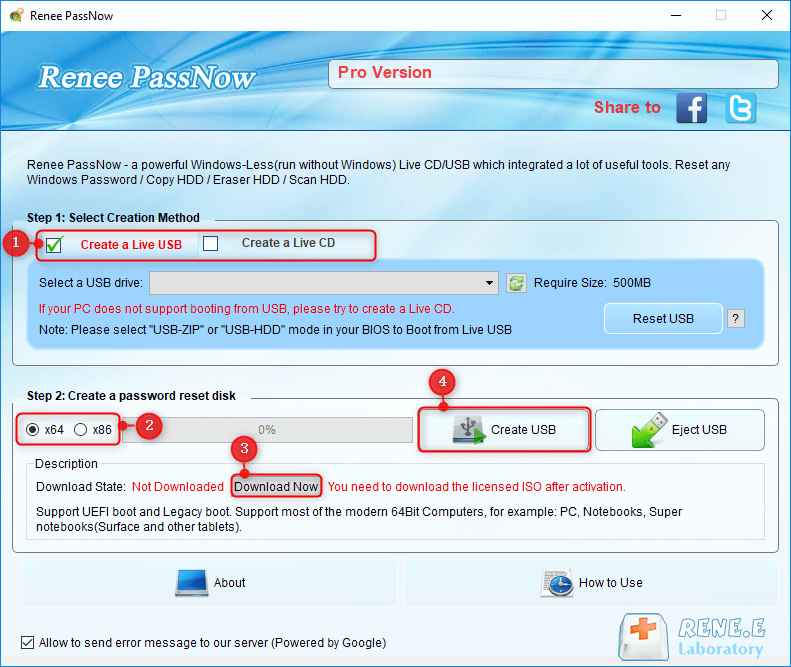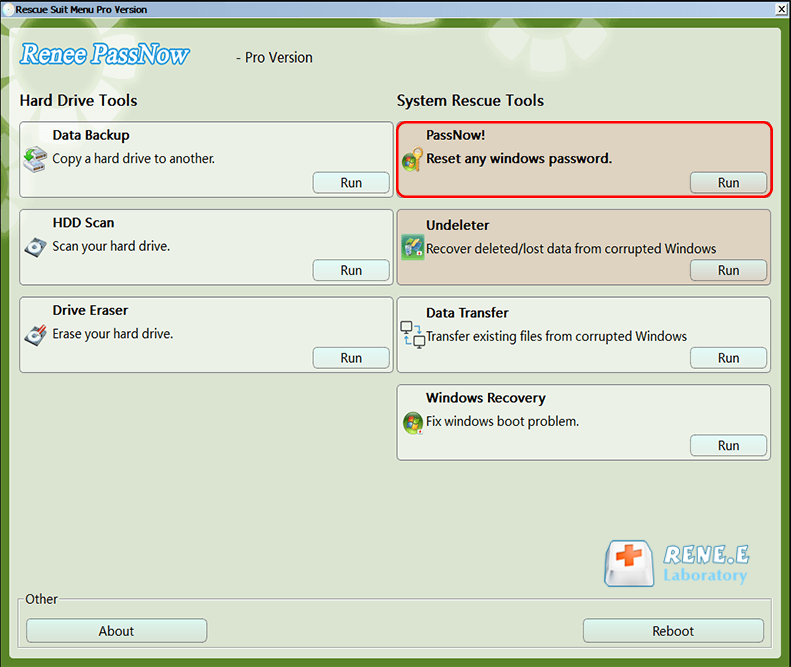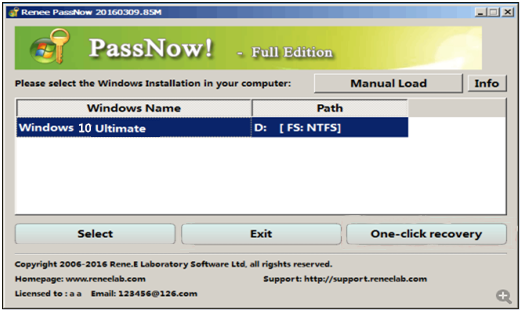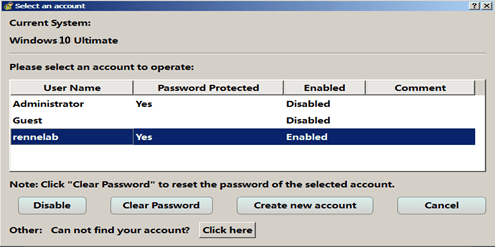Unlocking Your Lenovo Laptop: Resetting the Administrator Password on Windows 10
- Home
- Support
- Tips System Rescue
- Unlocking Your Lenovo Laptop: Resetting the Administrator Password on Windows 10
Summary
Locked out of your Lenovo laptop due to a forgotten administrator password on Windows 10? Don't panic! This article will guide you through various methods to reset the default administrator password on Lenovo laptops. Regain access to your laptop now!
Table of contents
Start by downloading Renee PassNow from the official website and install it on a different computer that you can access. You can choose the appropriate version based on your computer’s operating system.

Remove Windows Login Password 3 steps for whole password remove process.
Recover the files Recover the deleted files without Windows system.
Transfer the data Transfer the important files of the computer with system.
Multifuctional Data transfer, data recovery, bootable problem recovery can be run without system.
Highly compatible Windows 11/10/8.1/8/7/XP/Vista. UEFI boot.
Remove Login Password Support Windows 11/10/8.1/8/7/XP/Vista. UEFI boot.
Recover the files Recover the deleted files without Windows system.
Transfer the data Transfer the important files of the computer with system.
Launch Renee PassNow and insert a USB flash drive or blank CD/DVD into the computer. Select the option to create a bootable media. Follow the on-screen instructions to complete the process.

Insert the bootable USB or CD/DVD into the locked Windows computer. Restart the computer and enter the BIOS settings by pressing the appropriate key (usually F2 or Delete). Configure the boot order to prioritize the bootable media.
| Server Type | Enter boot menu method |
|---|---|
| DELL | Press the F12 key repeatedly before the Dell logo appears on the screen. |
| HP | Press the F9 key multiple times when the HP logo is displayed. |
| BIOS Name | Enter boot menu method |
|---|---|
| ASRock | DEL or F2 |
| ASUS | DEL or F2 for PCs/ DEL or F2 for Motherboards |
| Acer | DEL or F2 |
| Dell | F12 or F2 |
| ECS | DEL |
| Gigabyte / Aorus | DEL or F2 |
| Lenovo (Consumer Laptops) | F2 or Fn + F2 |
| Lenovo (Desktops) | F1 |
| Lenovo (ThinkPads) | Enter then F1 |
| MSI | DEL |
| Microsoft Surface Tablets | Press and hold Power and Volume Up buttons |
| Origin PC | F2 |
| Samsung | F2 |
| Toshiba | F2 |
| Zotac | DEL |
| HP | Esc/ F9 for `Boot Menu`/ Esc/ F10/ Storage tab/ Boot Order/ Legacy Boot Sources |
| INTEL | F10 |

After successfully booting from the bootable media, Renee PassNow will load. Select “PassNow!” function after booting from the new created Windows password reset disk.

Choose the user account for which you want to reset the password. Then, click on the “Clear Password” button. Renee PassNow will remove or reset the password for the selected user account.


Once the password is reset, remove the bootable media from the PC and restart the computer. You will now be able to log in to Windows Administrator Account without a password.
net user administrator /active:yes
- Restart your computer while holding the SHIFT button to access the Advanced Startup menu.
- Go to Troubleshoot > Advanced Options > Command Prompt.
- Type the following command:
net user administrator /active:yes
- Follow the steps mentioned above to access the Command Prompt.
- Type
regedit
HKEY_LOCAL_MACHINE\SOFTWARE\Microsoft\Windows\CurrentVersion\Policies\System
- Access the settings or preferences of the program.
- Look for options related to user account visibility.
- Ensure that the Administrator account is allowed to be displayed on the login screen.
- Restart your computer to apply the changes.
- Restart your computer while holding the SHIFT button to access the Advanced Startup menu.
- Go to Troubleshoot > Advanced Options > Startup Settings.
- Click the Restart button and choose Enable Safe Mode with Networking.
- Wait for your computer to boot and try to log in.
| Windows Version | How to Enter Windows safe mode | limitations |
|---|---|---|
| Windows 10/11 | Method 1: From the Sign-in Screen – Restart the computer. At the sign-in screen/ hold the Shift key and click Power > Restart. On the Choose an Option screen/ select Troubleshoot > Advanced Options > Startup Settings > Restart. After the computer restarts/ choose 4 or F4 for Safe Mode/ 5 or F5 for Safe Mode with Networking/ or 6 or F6 for Safe Mode with Command Prompt. | None |
| Windows 10/11 | Method 2: Interrupting the normal boot sequence – If Windows 10 fails to boot normally three times over/ it enters Automatic Repair mode. Interrupt the boot process three consecutive times using the Restart or Power button on your PC. When in Automatic Repair mode/ choose an account with administrator permissions/ enter the password if prompted/ and select Troubleshoot > Advanced Options > Startup Settings > Restart. After the computer restarts/ choose 4 or F4 for Safe Mode/ 5 or F5 for Safe Mode with Networking/ or 6 or F6 for Safe Mode with Command Prompt. | None |
| Windows 10/11 | Method 3: Using installation media and Command Prompt – Boot your broken Windows 10 PC from a Windows 10 setup DVD or USB. Choose the language and keyboard layout/ click Repair your computer/ select Troubleshoot > Command Prompt. Inside the Command Prompt window/ type ‘bcdedit /set {default} safeboot minimal’ and press Enter. Close the Command Prompt/ choose Continue/ and your PC will reboot into Safe Mode. Log in with an administrator account and make the desired changes. | The method using installation media and Command Prompt may require access to a Windows 10 setup DVD or USB. |
| Windows 10/11 | Method 4: Booting from a recovery drive – Create a system recovery USB drive on another Windows 10 computer. Boot your PC from the recovery drive and select Troubleshoot > Advanced Options > Startup Settings > Restart. After the computer restarts/ choose 4 or F4 for Safe Mode/ 5 or F5 for Safe Mode with Networking/ or 6 or F6 for Safe Mode with Command Prompt. | Requires creating a system recovery USB drive on another Windows 10 computer. |
| Windows 10/11 | Method 5: Using System Configuration (msconfig.exe) – Open System Configuration by searching for ‘system configuration’ in the taskbar search field. In the System Configuration window/ click the Boot tab and select the ‘Safe boot’ option. Click OK and restart your computer to enter Safe Mode. | Need Login |
| Windows 10/11 | Method 6: Using the Start Menu – Press and hold the SHIFT key on the keyboard. With the SHIFT key still pressed/ click the Start button/ then Power/ followed by Restart. Choose Troubleshoot/ go to ‘Advanced options -> Startup Settings -> Restart.’ Press 4 or F4 for Safe Mode/ 5 or F5 for Safe Mode with Networking/ or 6 or F6 for Safe Mode with Command Prompt. | Need Login |
| Windows 10/11 | Method 7: Using the Settings app – Open Settings (Windows + I)/ go to Update & security > Recovery. In the Advanced startup section/ click Restart now. Choose Troubleshoot/ go to ‘Advanced options -> Startup Settings -> Restart.’ Press 4 or F4 for Safe Mode/ 5 or F5 for Safe Mode with Networking/ or 6 or F6 for Safe Mode with Command Prompt. | Need Login |
| Windows 10/11 | Method 8: Using the shutdown command in CMD – Open Command Prompt and run the command ‘shutdown.exe /r /o’. After signing out/ choose Troubleshoot/ go to ‘Advanced options -> Startup Settings -> Restart.’ Press 4 or F4 for Safe Mode/ 5 or F5 for Safe Mode with Networking/ or 6 or F6 for Safe Mode with Command Prompt. | Need Login |
| Windows 10/11 | Method 9: Using F8 or Shift + F8 (doesn’t work for UEFI BIOS and SSD drives) – This method is not applicable for UEFI BIOS and SSD drives. | Doesn’t work for UEFI BIOS and SSD drives. |
| Windows Version | How to Enter Windows safe mode | limitations |
|---|---|---|
| Windows XP | Press the F8 key before the Windows XP logo appears. Use the arrow keys to select Safe Mode at the Advanced Boot Options menu. | None |
| Windows Vista | Press F8 before the Windows Vista logo appears. Use the arrow keys to select Safe Mode at the Advanced Boot Options menu. Another method is to type ‘msconfig’ in the Start menu’s Search field/ click the Boot tab/ check the Safe boot option/ select an option below/ and click OK/ then Restart. | When you reboot Windows after using the msconfig method/ it will take you back into Safe mode. So/ while still in Safe Mode/ launch msconfig and uncheck the Safe boot option. |
| Windows 7 | Press the F8 key before the Windows 7 logo appears. Use the arrow keys to select Safe Mode at the Advanced Boot Options menu. Another option is to insert the original installation disc/ select Repair your computer/ and then choose Command Prompt to run commands. Alternatively/ you can type ‘msconfig’ in the Start menu’s Search field/ click the Boot tab/ check the Safe boot option/ select an option below/ and click OK/ then Restart. | When you reboot Windows after using the msconfig method/ it will take you back into Safe mode. So/ while still in Safe Mode/ launch msconfig and uncheck the Safe boot option. |
| Windows 8 | If you can boot into Windows/ restart the computer and press the Shift and F8 keys before the Windows logo appears. If that doesn’t work/ you can also try using the Shift and Restart keys at the login window. From the Choose an option screen/ select Troubleshoot/ then Advanced options/ and finally Startup Settings. Click Restart and then press the F4 key to boot into Safe Mode. Another method is to type ‘msconfig’ in the Start menu’s Search field/ click the Boot tab/ check the Safe boot option/ select an option below/ and click OK/ then Restart. | When you reboot Windows after using the msconfig method/ it will take you back into Safe mode. So/ while still in Safe Mode/ launch msconfig and uncheck the Safe boot option. |
net user username *
net user username newpassword
wmic useraccount where name="username" set password
| Windows Version | Download Link | Requirement |
|---|---|---|
| Windows 7 | https://learn.microsoft.com/lifecycle/products/windows-7 | PC with a working Internet connection/ a blank USB flash drive or DVD with at least 8 GB of available storage space/ a product key |
| Windows 8/8.1 | https://www.microsoft.com/software-download/windows8 | Same to above |
| Windows 10 | https://www.microsoft.com/software-download/windows10 | Same to above |
| Windows 11 | https://www.microsoft.com/software-download/windows11 | Same to above |
cd C:\Windows\System32
ren Ultiman.exe Ultiman_backup.exe
ren cmd.exe Ultiman.exe
net user
net user "username" "new password"
net user Administrator /active:yes
cmd
net user administrator *
Relate Links :
Unlock the Hidden Default Administrator Account in Windows 7: Lenovo Edition
08-12-2023
Jennifer Thatcher : Unlock the hidden default administrator account in Windows 7 for Lenovo and regain control of your computer with...
Factory Resetting Windows 7 Without Password: A Step-by-Step Guide
13-10-2023
Amanda J. Brook : Struggling to factory reset your Windows 7 PC without a password? Look no further! In this article, we...
The Ultimate Guide to Recovering Your Forgotten Laptop Password
10-10-2023
John Weaver : Having trouble accessing your laptop because you've forgotten your password? Don't stress, we've got you covered with this...
Reset Password on Toshiba Laptop Satellite P855
20-10-2023
Jennifer Thatcher : Unlock your Toshiba Satellite P855 by learning various methods to reset passwords, including using the jumper, Renee PassNow,...




